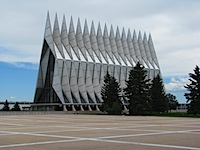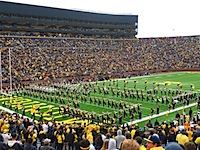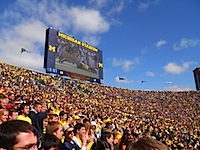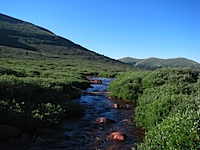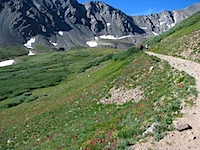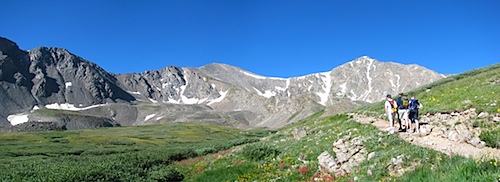A few days ago an op-ed appeared on FoxNews.com by a couple people from the Competitive Enterprise Institute, entitled, “Do We Really Need a National Weather Service?” I think it’s one of the more poorly-reasoned op-eds I’ve seen in quite some time. I’ll reproduce the op-ed here in italics, but interspersed with my own comments, Fire Joe Morgan-style. So here we go.
As Hurricane Irene bears down on the East Coast, news stations bombard our televisions with constant updates from the National Hurricane Center.
While Americans ought to prepare for the coming storm, federal dollars need not subsidize their preparations.
Providing weather forecasts for free is not the same thing as subsidizing storm preparations. If the NWS was buying plywood, bottled water, generators, or gas for the public, that would be subsidizing storm preparations.
Although it might sound outrageous, the truth is that the National Hurricane Center [NHC] and its parent agency, the National Weather Service [NWS], are relics from America’s past that have actually outlived their usefulness.
O RLY? This should be interesting.
The National Weather Service (NWS) was founded in 1870. Originally, the NWS was not a public information agency. It was a national security agency and placed under the Department of War. The Service’s national security function has long since disappeared, but as agencies often do, however, it stuck around and managed to increase its budget.
Apparently agencies should not adapt to changing user needs. The first name of the NWS, even when it was in the Department of War (which is now the Department of Defense), was “The Division of Telegrams and Reports for the Benefit of Commerce.” Clearly it was founded with the intent of benefitting commerce and private citizens. It was only in the Department of War because they wanted observations taken regularly, and the military was reliable with routine. By 1890 the Weather Bureau was moved to the Department of Agriculture, and in 1940 it was moved to the Department of Commerce, where it remains to this day (it was renamed the National Weather Service in 1967).
Today the NWS justifies itself on public interest grounds.
The NWS has been serving the public interest for almost their entire history.
It issues severe weather advisories and hijacks local radio and television stations to get the message out. It presumes that citizens do not pay attention to the weather and so it must force important, perhaps lifesaving, information upon them.
How dare these evil meteorologists advise people that a deadly tornado or flash flood is bearing down on their town! What nerve!
A few seconds’ thought reveals how silly this is.
Ummm… What?
The weather might be the subject people care most about on a daily basis. There is a very successful private TV channel dedicated to it, 24 hours a day, as well as any number of phone and PC apps. Americans need not be forced to turn over part of their earnings to support weather reporting.
And guess where almost ALL the information that all these private weather companies comes from? That’s right, the National Weather Service! The NWS (and its parent organization NOAA, the National Oceanic and Atmospheric Administration) is mandated by law to provide all its data to the public for FREE. That includes in situ observations like the surface observation network, radiosondes (weather balloons), dropsondes, and aircraft observations. It includes remotely sensed observations from a host of multi-million-dollar satellites that observe the entire globe. It also includes data from numerical weather prediction (NWP) models, and ensembles of these NWP models (and I can tell you from personal experience with my research and experience that NWP ensembles are incredibly expensive to run in terms of computing power). If private companies had to build and maintain all this on their own, there wouldn’t be any such thing as free public forecast data.
Also, the annual budget of the NWS is currently about $1 billion. That works out to about $3/year per person. I think everyone nationwide gets more than $3/year of benefit out of the NWS. I think we get more bang for our buck from the NWS than we do from almost any other government agency.
The NWS claims that it supports industries like aviation and shipping, but if they provide a valuable contribution to business, it stands to reason business would willingly support their services. If that is the case, the Service is just corporate welfare. If they would not, it is just a waste.
Many private companies do sell their forecast products to businesses, if the businesses decide they want products that are more specialized to their needs than the free information they can already obtain from the NWS. There is a tremendous market for niche specialization of forecasts. The NWS does not cater its forecast products to each specific users’ needs for a reason, and that’s because it’s outside the scope of its mission. The NWS is not corporate welfare.
As for hurricanes, the insurance industry has a compelling interest in understanding them. In a world without a National Weather Service, the insurance industry would probably have sponsored something very like the National Hurricane Center at one or more universities. Those replacements would also not be exploited for political purposes.
Are you kidding me?!? Do these people want to admit they have no critical thinking skills? The insurance industry is only interested in hurricane climatologies, not in better forecasting any individual storm. They’d try to guess at the total number of tropical storms and hurricanes over the course of the season, but that’s about it. Being able to forecast the track or intensity of an individual storm would not do anything to help mitigate their losses or increase their profits. The only way it would is if they allowed people to buy hurricane insurance when it becomes clear a hurricane’s heading their way, but then it wouldn’t be insurance. (You can’t buy homeowners insurance if a forest fire is bearing down on your property, and you can’t buy health insurance after you get sick and expect to be covered — oh wait, Obamacare redefined the meaning of health “insurance,” but that’s a whole ‘nother post.)
For Hurricane Irene, the NHC’s track forecast was excellent. Five days out they predicted landfall somewhere near the NC/SC border, and by one day out their track error was down to 10 miles. That’s phenomenal. 20-30 years ago, the typical one-day track error was what the five-day track error was with Irene last week. Their intensity forecast was a bit off, but hurricane intensity has been a bugaboo for decades because there are still great mysteries with hurricanes that we haven’t yet figured out. The reason why a stronger hurricane was predicted was that the hurricane looked like it was going through another eyewall replacement cycle a day or two before landfall, except a new eyewall never formed. We don’t know why. Many good scientists have been and continue to research this area, but more funding is necessary before we’ll unlock the secret to making good intensity forecasts (and figuring out how to predict eyewall replacement cycles is a huge part of that).
As it stands today, the public is forced to pay more than $1 billion per year for the NWS. With the federal deficit exceeding a trillion dollars, the NWS is easily overlooked, but it shouldn’t be.
True, the government spends way, WAY too much money. The government has a huge spending problem. I think that government spending ought to return to about the long-term normal 18-20% of GDP from the 25% that it’s skyrocketed to under President Obama (it was about 21% or 22% of GDP when he took office). But that doesn’t mean that everything should be cut. I think that every single government expenditure ought to be rated on a scale ranging from “vital” to “important” to “useful” to “luxury/unnecessary” to “waste” (or similar). On such a scale, I would place the NWS somewhere on the “vital” part of the scale. The NWS is one of the LAST agencies that should be up for drastic cuts or elimination.
It may actually be dangerous.
You know what else can be dangerous? Faulty reasoning fueling incendiary rhetoric by people who don’t have a clue what they’re talking about.
Relying on inaccurate government reports can endanger lives. Last year the Service failed to predict major flooding in Nashville because it miscalculated the rate at which water was releasing from dams there. The NWS continued to rely on bad information, even after forecasters knew the data were inaccurate. The flooding resulted in 22 deaths.
It doesn’t matter if the report comes from government or private agencies, inaccurate forecasts can result in people not getting themselves out of harm’s way. As every single weather forecaster will tell you, everyone has busted forecasts from time to time. Less skilled forecasters have busted forecasts more frequently.
As for the Nashville flooding, the bad data came from the U.S. Army Corps of Engineers. Check out the actual NWS internal report, or a more informative newspaper article than the one CEI linked to in their story. The NWS absolutely screwed up, as their report indicates. But a lot of the blame also lies at the feet of the U.S. Army CoE. Everyone has busted forecasts and makes mistakes, but this one unfortunately probably contributed to a few deaths. NWS is learning from this terrible mistake and correcting their procedures, you can be assured of that.
Furthermore, would any private company want the responsibility of issuing public severe weather watches, warnings, and advisories? There would be huge liability issues there. Also, would we have ten different companies each issuing their own competing warnings? Would there need to be legislation mandating that one company be in charge of warnings?
NWS has vastly improved warning times for tornadic thunderstorms, so that now the average warning time for a tornado is about 20 minutes. That’s phenomenal, and it’s going to be hard to do much better than that until we know why some thunderstorms become tornadic and why others don’t. People are working on that, but we need more research dollars for that.
Private weather services do exist, and unsurprisingly, they are better than the NWS. When Hurricane Katrina hit New Orleans in 2005, the National Weather Service was twelve hours behind AccuWeather in predicting that New Orleans would be affected.
One case of AccuWeather being 12 hours quicker in predicting that a hurricane would hit New Orleans doesn’t make their case that NWS sucks at forecasting hurricanes. You can’t prove anything from one data point. Statistics FAIL. AccuWeather is also known for breathlessly overhyping countless storms, either into a monster category 5 roaring up the east coast, or into the blizzard of the century. Joe Bastardi was particularly guilty of this while he worked at AccuWeather. There’s a reason why my friends from Penn State and I call their forecasts “AccuMongering.”
[UPDATE at 8:45am MDT on 1 Sep 2011: I found another site that compares the NWS and AccuWeather forecasts for Hurricane Katrina. Looks to me like NWS had a far better forecast three days in advance of Katrina’s landfall on the Mississippi coast.]
Unlike the NWS, AccuWeather provides precise hour-by-hour storm predictions, one of the reasons private industry supports them.
Yes, some industries require hourly forecasts, such as the energy sector. That’s why NCAR (where I work) is under contract to help build a good wind forecasting system for Xcel Energy currently, for instance. Right or wrong forecasts for a single event can lead to savings or costs of millions of dollars. It’s big business. But the NWS doesn’t issue hourly forecasts because most of the public doesn’t need it. When companies want it, they pay for a source that will provide them with such info if it proves beneficial to them.
It is not just random mistakes in crises either. Forecast Watch has found that the National Weather Service predictions of snow and rain have an error rate 20 percent higher than their private alternatives. “All private forecasting companies did much better than the National Weather Service,” their report concludes.
What the CEI authors didn’t disclose was that the Forecast Watch study compared NWS to only three private companies: The Weather Channel, DTN Meteorologix, and CustomWeather, so saying that NWS is poorer than “all” private companies is an overstatement. Also, the study was done over just a nine-month period, Oct 2006-Jun 2007. There is value in this study, to be sure, but it would be better to do these comparisons at least over an entire calendar year, and preferably more than one year. It would also be interesting to find out if certain WFOs (weather forecast offices) in the NWS were better than others at predicting probability of precipitation, and if there were any regions in which NWS outperformed those private companies. NWS certainly has room to improve in predicting probabilities of precipitation, however, as does everyone.
In 2008, they found that the NWS’s temperature predictions were worse than every private-sector competitor including the Weather Channel, Intellicast, and Weather Underground.
The CEI authors did not link to an actual study, so I can’t evaluate their claim. I will note, however, that the extended forecast product for Weather Underground is the verbatim NWS zone forecast. If NWS sucked, then why is Weather Underground using NWS forecasts? Also, The Weather Channel so frequently had terrible temperature forecasts by relying on MOS that my Penn State friends and I called it “The Weather Channel Slot Machine.”
Even NWS’s online ZIP code search for weather reports is in some cases totally inaccurate, giving reports for areas hundreds of miles away.
No examples were given. I have never encountered this problem, for what it’s worth. I haven’t even heard of this problem before, so I really wish they would’ve given concrete examples.
NWS claims to spread information, but when the topic of budget cuts came up earlier this year, all they spread was fear. “There is a very heightened risk for loss of life if these cuts go through,” NWS forecasters said, “The inability for warnings to be disseminated to the public, whether due to staffing inadequacies, radar maintenance problems or weather radio transmitter difficulties, would be disastrous.”
I happen to agree with NWS here. One of the contributing factors to the blown forecasts of the Nashville floods (which CEI brought up earlier) was that the forecasters were overwhelmed. Fewer staff and fewer resources will help prevent history from repeating itself?
Disastrous? The $126 million in cuts would still have left the Service with a larger budget than it had a decade ago.
How about in inflation-adjusted dollars? Also, there are more observing networks to maintain, and more expensive modeling systems to run. Sure, we could go back to the models of a decade ago, but the public would not like the resultant degradation in forecast skill. The private sector wouldn’t, either, because the quality of their forecasts is dependent on that NWS data.
The massive bloat in government should not get a pass just because it’s wrapped in good-of-the-community clothing.
The authors haven’t done anything to show that there’s massive bloat in NWS. That would’ve required actual examination of the NWS budget items.
NWS services can and are better provided by the private sector.
Except that the private sector relies almost entirely on the free data and services provided by the NWS and other governmental agencies from around the world.
Americans will invest in weather forecasting because if there is one thing we can be certain of, people will want to protect their property and their lives.
And that’s exactly why NWS exists and why our government invests in it, to protect life and property! Argh!
In closing, the authors might be worth listening to if they actually made a good argument that didn’t rely on misrepresentation of facts, omission of facts, or ridiculous arguments. When they can’t even treat their argument knowledgeably or honestly, they deserve to be exposed for it. I’m not saying this just because it’s “close to home” as a meteorologist. But because it’s “close to home” I can show their arguments to be downright silly. For an additional take on it, check out this article from another PhD meteorologist.







